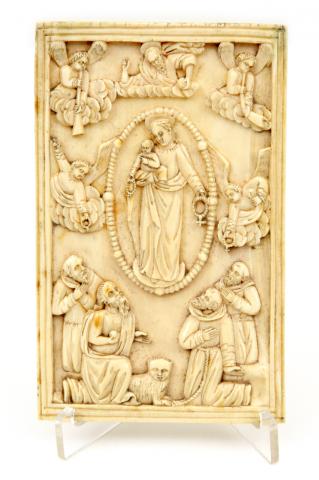Placa de Nossa Senhora do Rosário
A Madonna of The Rosary plaque
Marfim
Sino-Portuguese, 17th century
Dim.: 13.4 x 8.4 cm
Placa de Nossa Senhora do Rosário
Marfim
Sino-portuguesa, séc. XVII
Dim.: 13,4 x 8,4 cm
Sino-Portuguese low-relief plaque depicting The Madonna and The Child, suspended in full Glory in the celestial space, while standing on the lunar crescent encircled by the Rosary beads.
The figures are surmounted by the Holy Father holding the Terrestrial Globe – symbol of authority, and surrounded by four angels, two herald and another two flanking the Rosary. All these characters are supported on clouds of fine and sinuous outlines forming small overlapping circles, a type of motif characteristic of Sino-Portuguese imagery. A curious composition detail is the fact that both the Madonna and the Child are portrayed holding a Rosary, being themselves framed by one and flanked by two angels of identical depiction, in a total of five allusions to this symbol of the Church, a fact that illustrates its importance at the time of production, and one that is certainly not unrelated to its hybrid character.
On the lower right corner two devout barefoot Franciscan friars, looking upwards with hands raised in prayer, with the tonsure, the rope belted plain hanging habit and the hooded mozzetta; in the opposing corner Saint Francis and Saint Jerome, with his lion attribute, praying to the Virgin Mary.
Imagery representing the Virgin holding the Child Christ on the right arm and the beads Rosary on the left, was produced in large numbers in the whole of Portuguese India, including in Ceylon, where the Portuguese landed in 1507, but also in China, from where some of the finest and more delicate examples originate.
This particular Madonna composition, commonly known as the Madonna of The Rosary, stands out from within the restrict group of similar extant pieces, both for the finesse and elegance of its manufacture and for its exceptional artistic quality of distinct classical or renaissance flavour.
Relevo sino - português em placa de marfim com Nossa Senhora e Menino, planando no espaço celestial em plena glória, tendo aos seus pés a meia-lua e rodeados pelas contas do rosário.
Está encimado pelo Padre Eterno que segura o globo do mundo (símbolo de autoridade) e rodeada por quatro anjos, dois anjos arautos e dois a ladearem o rosário. Todas estas figuras estão suportadas por nuvens com um recorte fino e sinuoso, formando pequenos círculos sobrepostos, num trabalho característico da imaginária sino-portuguesa. Curioso é constatar que Nossa Senhora e o Menino seguram um terço, eles próprios emoldurados por um rosário de contas e ladeados, por dois Anjos na mesma representação, num total de cinco alusões a este símbolo da igreja, o que mostra a sua relevância na época, e à qual também não é estranho o caráter miscígeno.
No canto inferior direito ajoelham-se devotamente dois franciscanos descalços, de mãos postas e rosto erguido, com a sua longa tonsura, o hábito escorrido com o cinto de corda e a murça com capucho; no canto contra-lateral, São Francisco e São Jerónimo, prestam culto à Virgem.
As imagens da Virgem sustentando o Menino Jesus no braço direito e o rosário de contas na mão esquerda, foram executadas em grande número ao longo de toda a Índia Portuguesa, incluindo no território cingalês, onde os Portugueses chegaram em 1507, mas também na China de onde são originários alguns dos exemplares mais delicados.
Esta Nossa Senhora, também designada Nossa Senhora do Rosário, destaca-se pela sua delicadeza e elegância. É de assinalar a sua qualidade artística de sabor clássico ou renascentista.
- Arte Colonial e Oriental
- Arte Cristã
- Marfins

